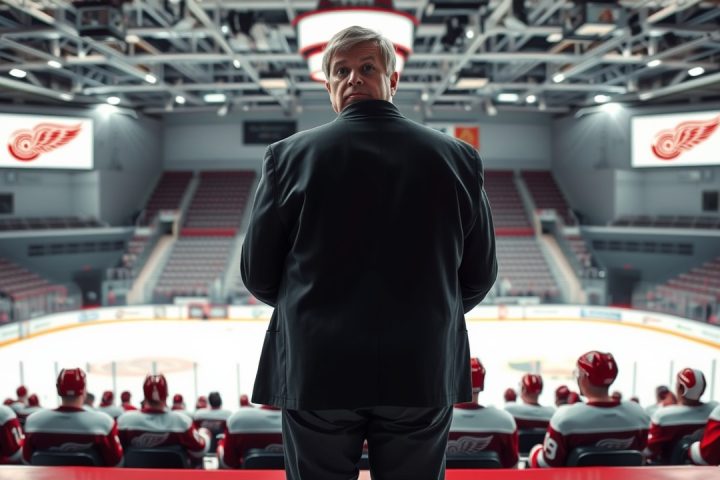The Role of Third-String Goalies in the NHL
The role of third-string goalies in the NHL often goes unnoticed, yet their contributions can lead to unexpected moments of triumph. Scott Wedgewood provides a poignant case study in this phenomenon.
Wedgewood’s Story with the Tampa Bay Lightning
During the Tampa Bay Lightning‘s celebratory pass of the Stanley Cup in September 2020, Wedgewood remained in the background, aware that he was not the one who had logged any minutes on the ice during their championship run against the Dallas Stars. Serving as the team’s No. 3 goalie throughout the playoffs, he was in the Toronto and Edmonton bubbles primarily as a precaution, ready to step in should anything happen to either starter Andrei Vasilevskiy or backup Curtis McElhinney—fortunately, nothing did.
Mixed Emotions and Personal Responsibility
As the Cup was handed down the lineup from captain Steven Stamkos to the various players, Wedgewood experienced a mix of emotions.
“I kind of didn’t earn it, but I earned it,”
he recounted, reflecting on his complex feelings about the achievement. Finally, after the players had their turn, forward Mathieu Joseph presented the Cup to Wedgewood. Taking a brief victory lap around the ice with the illustrious trophy, he felt the weight of the moment, even as a voice questioned whether he truly belonged there.
A Moment of Honor
Wedgewood turned to Stamkos, considering the moment’s significance for their coach, Jon Cooper. He proposed the captain present the Cup to Cooper instead.
“No! You f—ing do it!”
shouted an exuberant Stamkos. Thus, Wedgewood had the honor of delivering hockey’s most coveted trophy to a coach who is likely destined for the Hall of Fame, all without having participated in a single playoff game.
The Valuable Support Role
Today, Wedgewood is the backup for the Colorado Avalanche but retains fond memories of his time with the Lightning. He points out that third-string goalies may seem peripheral, yet their support roles are indispensable during a playoff run. They are available for emergency situations and practice, which is a vital function in maintaining team synergy, as emphasized by Panthers coach Paul Maurice.
The Evolution of the Role
Historically, the role of a third-string goalie was negligible; it wasn’t until the 1965-66 season that the NHL required teams to dress two goalies. Nowadays, teams typically carry three, as playoff rosters are expanded for contingencies. Evaluating which goalie occupies the No. 3 spot involves considering factors such as the status of affiliate teams in the AHL playoffs.
Learning Through Experience
As playoff participations continue to evolve, some teams opt for less experienced young goalies, like Wedgewood at the time, who found the opportunity invaluable for hands-on learning from established players and coaches. Other teams may utilize experienced veterans such as Jonathan Quick, whose mere presence can bolster the confidence of the starting goalie, even if he doesn’t play in the playoffs.
Commitment to Teammates
Wedgewood himself embraced his role during his time with Tampa Bay, organizing team activities and remaining accessible, even stepping in for Vasilevskiy during practices when needed. His commitment to his teammates and their training exemplified the spirit of cooperation essential for playoff success. He racked up countless hours participating in off-ice activities, underscoring his camaraderie with the Lightning players.
Unique Challenges Faced
In rare circumstances, third-string goalies have been called into action during playoff games, as seen in several recent seasons. Only one Stanley Cup-winning team since 1938—the 2016 Pittsburgh Penguins—has relied on a third-string goalie during playoffs, highlighting how unique and challenging this role can be.
Reflections on the Experience
As Wedgewood looks back on lifting the Cup, he likens it to hitting a hole-in-one in golf, emphasizing that the manner of achieving it does not diminish its significance. However, he is aware that his experience differs from players who took to the ice during the Stanley Cup run. Reflecting on potential future reunions with his championship team, he leaves the door open to how his involvement will be perceived.
Conclusion
Ultimately, through all the highs and lows of NHL playoff seasons, third-string goalies have their day in the Cup’s glory, even if their paths to that moment diverge significantly from their more prominent counterparts. The spirit of being part of a championship team resonates, with every contribution valued, regardless of the position on the depth chart. The emotional validation, recognized by coaches and teammates alike, reaffirms their roles even in a primarily supportive capacity.
Wedgewood’s experience illustrates that while the spotlight might not shine on third-string goalies, their dedication can lead to moments that forever intertwine their narratives with that of a championship team. This complex identity of being both a vital support and an external participant beautifully encapsulates the unique role that players like Wedgewood play in the grand journey of an NHL season.




